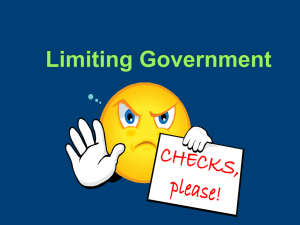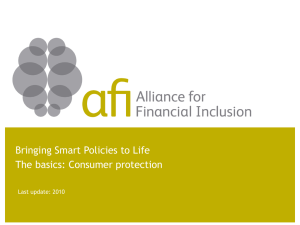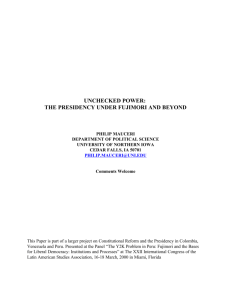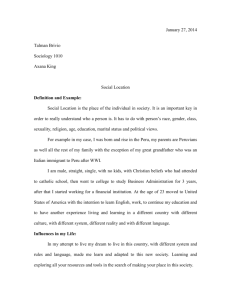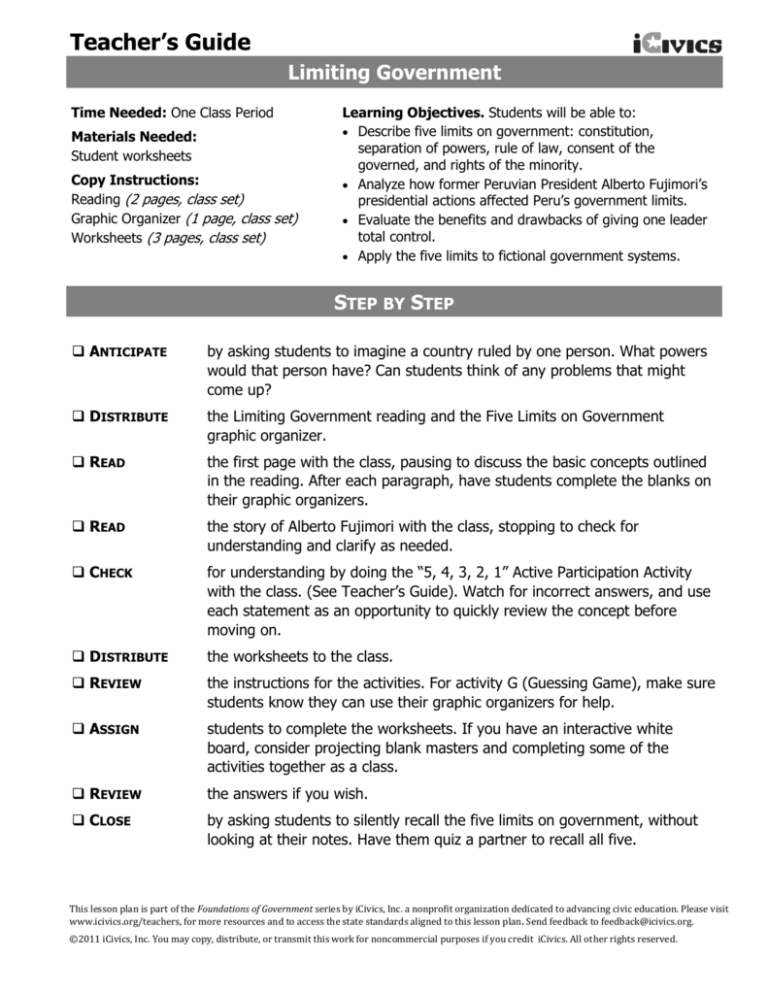
Teacher’s Guide
Limiting Government
Time Needed: One Class Period
Materials Needed:
Student worksheets
Copy Instructions:
Reading (2 pages, class set)
Graphic Organizer (1 page, class set)
Worksheets (3 pages, class set)
Learning Objectives. Students will be able to:
Describe five limits on government: constitution,
separation of powers, rule of law, consent of the
governed, and rights of the minority.
Analyze how former Peruvian President Alberto Fujimori’s
presidential actions affected Peru’s government limits.
Evaluate the benefits and drawbacks of giving one leader
total control.
Apply the five limits to fictional government systems.
STEP BY STEP
ANTICIPATE
by asking students to imagine a country ruled by one person. What powers
would that person have? Can students think of any problems that might
come up?
DISTRIBUTE
the Limiting Government reading and the Five Limits on Government
graphic organizer.
READ
the first page with the class, pausing to discuss the basic concepts outlined
in the reading. After each paragraph, have students complete the blanks on
their graphic organizers.
READ
the story of Alberto Fujimori with the class, stopping to check for
understanding and clarify as needed.
CHECK
for understanding by doing the “5, 4, 3, 2, 1” Active Participation Activity
with the class. (See Teacher’s Guide). Watch for incorrect answers, and use
each statement as an opportunity to quickly review the concept before
moving on.
DISTRIBUTE
the worksheets to the class.
REVIEW
the instructions for the activities. For activity G (Guessing Game), make sure
students know they can use their graphic organizers for help.
ASSIGN
students to complete the worksheets. If you have an interactive white
board, consider projecting blank masters and completing some of the
activities together as a class.
REVIEW
the answers if you wish.
CLOSE
by asking students to silently recall the five limits on government, without
looking at their notes. Have them quiz a partner to recall all five.
This lesson plan is part of the Foundations of Government series by iCivics, Inc. a nonprofit organization dedicated to advancing civic education. Please visit
www.icivics.org/teachers, for more resources and to access the state standards aligned to this lesson plan. Send feedback to feedback@icivics.org.
©2011 iCivics, Inc. You may copy, distribute, or transmit this work for noncommercial purposes if you credit iCivics. All other rights reserved.
Limiting Government
Name:
Limiting Government? What’s the Big Deal?
Sometimes you might hear people talking as if government is an evil
monster. Are they overreacting? Are there reasons to fear
government? Whose side is government on, anyway? Throughout
history, there have been governments that had too much power and
ended up abusing that power. They limited people’s freedom,
mistreated people, and even committed mass murders. In some
places, that still happens today. Government isn’t evil—but the people
who run governments do need to be kept in check so they can’t abuse
their power. There are several ways to limit government power.
A Constitution
From 1926-1943, Benito Mussolini
ruled Italy as a dictator with total
control of the government.
A constitution is the rulebook for a country’s government. A constitution
usually explains what kind of government a country has and how that
government functions. It also tells how a country’s laws are made, and it
explains the rights and responsibilities of citizens. Most modern countries
have written constitutions.
The Rule of Law
The rule of law means laws are fair, they’re enforced, and nobody is
above the law. When a country has the rule of law, even the government
must follow the law. The law applies to everyone—even the president!
Citizens feel secure that the government can’t just do what it wants, and
there are procedures in place to make sure the law is enforced.
Separation of Power
Separation of power is dividing power among several branches of
government. By dividing up the power, a country can make sure that no
one person or part of government gets too much control. Separation of
power works because each branch of government is able to “check,” or
limit, what the other branches can do. Each branch is responsible for a
different government function.
Consent of the Governed
When you give your consent, you are giving permission. The consent of
the governed means that the citizens of a country give their permission
to be governed by the country’s government, and they do this by voting.
Citizens have the right to vote, and they can use their vote to change the
government. By voting, citizens can even change the constitution!
Rights of the Minority
In a system where the citizens are the government because leaders are
elected by voting, limiting government also means limiting the power of
the majority. In voting, the majority rules. It would be possible for the
majority to treat a minority group unfairly. Protecting the rights of the
minority means protecting the rights of small or unpopular groups
regardless of what the majority believes. Everyone must be treated fairly.
Reading p.1
Limiting Government
Name:
Alberto Fujimori: Power in Peru
New President, Big Ideas
In 1990, a man came to power in Peru who would do things that would
shock the world. Peru is a large country in South America. Like the United
States, Peru has a constitution that creates a government with a
president, a congress, and a judicial system. But in the 1990s, something
happened in Peru that has never happened in America.
Alberto Fujimori was born in Peru after his parents emigrated from Japan.
When Peruvians elected him to be their president in 1990, he was very
popular. Peru had huge financial problems, and Fujimori had ideas for
making Peru more prosperous. He also had ideas for dealing with a group
of terrorists that had been causing problems in the country. But Peru’s
Congress was filled with lawmakers who opposed Fujimori, and they
refused to pass any of his ideas into law.
Fujimori Takes Control
Fujimori after his election in 1990
On the night of April 5, 1992, Fujimori took matters into his own hands.
He went on television and told Peruvians he was “temporarily dissolving”
Congress and that he would “reorganize” the judicial branch. There was
only one problem: Peru’s constitution did not give Fujimori the power, as
president, to do these things. But Fujimori had a solution for that. He
used military tanks and tear gas to keep Congress from meeting. He
arrested people who disagreed with him, and he also arrested popular
journalists and businessmen. Just to be safe, he even arrested the man
who had been president before him.
Fujimori with some of his military
and government leaders
And then Fujimori set his sights on Peru’s constitution. He issued a
decree, or presidential order, saying the constitution could be ignored. His
decree also got rid of Congress and gave the president the power to make
all the laws. Fujimori then fired almost half of Peru’s 23 Supreme Court
justices, as well as many other judges around Peru who believed his
actions were unconstitutional.
The Autocrat Falls
Having secured control of Peru’s government, Fujimori now had no
trouble carrying out his ideas. He solved Peru’s financial crisis, and he
successfully dealt with the terrorists that had taken control of several
parts of the country. These and other actions made him popular.
But that wasn’t all Fujmori did. With no independent judicial system,
thousands of suspected terrorists were killed without ever having a trial.
On top of this, scandal broke when one of Fujimori’s government officials
was caught smuggling drugs, stealing government money, interfering
with elections, and selling weapons to terrorists in other countries.
Fujimori went to Japan to hide from the scandal. The scandal allowed
Fujimori’s opposition to gain control, and government in Peru was
restored. Later, Fujimori was sentenced to six years in prison for abusing
his power and 25 years for human rights abuses in Peru.
Peruvian newspapers announce
Fujimori’s 25-year prison sentence
for human rights abuses
Reading p.2
Limiting Government
Name:
A. Mark It Up. Go back through Alberto Fujimori: Power in Peru and complete the following steps:
1. Circle four things that should have kept Fujimori’s power in check.
2. Underline the actions Fujimori took to get rid of those checks.
3. Draw a rectangle around the bad things that happened after Fujimori had complete control.
B. Sequence. Number the following events from 1 to 8 in the order that they happened (1 is first).
_______ A. Fujimori successfully solves the economic problems and terrorism troubles in Peru.
_______ B. Fujimori tries to solve the economic crisis, but runs into too many obstacles.
_______ C. Fujimori is sentenced to a total of 31 years in prison.
_______ D. Fujimori dissolves Congress and says the constitution can be ignored.
_______ E. President Fujimori flees to Japan.
_______ F. Fujimori is elected president of Peru.
_______ G. Fujimori uses tanks and tear gas to stop Congress from meeting.
_______ H. Scandal breaks out over illegal activity in Fujimori’s government.
C. Pros and Cons. What are the benefits of giving one leader total control? What are the drawbacks?
Brainstorm four ideas for each and fill in the organizer below. You don’t have to repeat what’s in the
reading — it’s okay to use your own ideas!
Worksheet p.1
Limiting Government
Name:
D. No Limits! Read each event. Which limit on government failed? Write it on the line above the event.
1. Fujimori’s government interfered with elections.
Failed: __________________________________________
2. Fujimori’s government ignored the rights of suspected terrorists.
Failed: __________________________________________
3. Fujimori dissolved Peru’s Congress
Failed: __________________________________________
4. Fujimori ordered the Constitution to be ignored.
Failed: __________________________________________
5. Fujimori did what he wanted, regardless of the law.
Failed: __________________________________________
E. Review. Solve the clues to complete the crossword puzzle. Use the first page of the reading for help.
1
Across
3. Minority rights are needed in order to
treat everyone this way.
2
4. The people who run governments must
be kept in ____.
5. Means giving permission.
3
6. How citizens give their consent to a
government.
4
5
8. The rights of the minority limit the power
of this group.
Down
1. When there’s rule of law, this is who the
law applies to.
6
7
8
2. When there’s rule of law, there are
procedures to make sure the law is ___.
3. What people fear will be limited if a
government has too much power.
5. With separation of power, no branch has
too much of this.
7. A Constitution tells how these are made.
Worksheet p.2
Limiting Government Carrie’s attempt
Name:
E. Limits to Government. For each fictional country, mark which limits the country does not have.
Limits that are missing:
Limits that are missing:
Constitution Rule of Law Minority Rights
Consent of the Governed Separation of Power
Constitution Rule of Law Minority Rights
Consent of the Governed Separation of Power
F. What do you think? Fill in the boxes below. Take this opportunity to express your opinion!
Rank the limits of government
in order from 1 (most
important limit) to 5 (least
important limit).
I ranked __________________
I ranked __________________
as most important because____
as least important because____
__________________________
__________________________
____ Constitution
__________________________
__________________________
____ Rule of Law
__________________________
__________________________
____ Minority Rights
__________________________
__________________________
____ Consent of Governed
__________________________
__________________________
____ Separation of Power
__________________________
__________________________
__________________________
__________________________
G. Guessing Game. Choose one limit on government. Use the descriptions in (E) above as a model to
write your own description about a fictional country that does NOT have that limit. Then read your
description aloud and see if your classmates can guess which limit is missing.
Worksheet p.3
Limiting Government
Name:
A constitution is _________________
__________________________________________________
Limits government like this:
Tells how a country’s __________ are made
Tells how government ___________
Rights of the
Minority protects the
means laws are
Lists the __________ and
rights of ________________
_______, ____________
_____________________
_________________________
and nobody is _______ the law
of citizens.
Limits government like this:
Rule of law
Limits government like this:
The law applies to ____________
Limits the power of the
Even the ________________
________________________
must follow the law
Makes sure everyone is treated
There are procedures to make
__________________
sure the law is ________________
Protects even _____________ or
_______________ groups
Separation of power
Consent of the governed means
citizens give their _____________ to be governed
Limits government like this:
Citizens have the right to ___________
Citizens can use their vote to
___________the government
Citizens can even change the
_____________________
by voting!
divides ________________________________
_______________________________________
Limits government like this:
No branch gets too much _____________
Each branch can “________________”
what the other branches can do
Each branch is responsible
for a different
_____________
Graphic Organizer
Limiting Government
** TEACHER’S GUIDE **
Active Participation Activity: 5, 4, 3, 2, 1
Directions: On the board, write the following:
Constitution
5
Separation of Powers
4
Rule of Law
3
Consent of the Governed
2
Rights of the Minority
1
Tell students you are going to read a series of statements. For each statement, they should tell you
which of the limits on government is being described by holding up a hand showing the correct
number of fingers.
1. Means that citizens give their permission to be governed. (2 — Consent of the Governed)
2. Explains what kind of government a country has. (5—Constitution)
3. Means that nobody is above the law. (3 — Rule of Law)
4. Divides power among several branches of government. (4 — Separation of Powers)
5. Makes sure even small and unpopular groups are treated fairly. (1 — Rights of the Minority)
6. Makes sure no one part of government gets too much control. (4 — Separation of Powers)
7. Explains the rights and responsibilities of citizens. (5 — Constitution)
8. Happens when citizens use their votes to affect government. (2 — Consent of the Governed)
9. Requires even the government to follow the law. (3 — Rule of Law)
10. Limits the power of the majority. (1 — Rights of the Minority)
Active Participation Guide
Limiting Government
Name:
** TEACHER’S GUIDE **
A. Mark It Up. Go back through Alberto Fujimori: Power in Peru and complete the following steps:
1. Circle four things that should have kept Fujimori’s power in check.
2. Underline the actions Fujimori took to get rid of those checks.
3. Draw a rectangle around the bad things that happened after Fujimori had complete control.
B. Sequence. Number the following events from 1 to 8 in the order that they happened (1 is first).
___5___ A. Fujimori successfully solves the economic problems and terrorism troubles in Peru.
___2___ B. Fujimori tries to solve the economic crisis but runs into too many obstacles.
___8___ C. Fujimori is sentenced to a total of 31 years in prison.
___3___ D. Fujimori dissolves Congress and says the Constitution can be ignored.
___7___ E. President Fujimori flees to Japan.
___1___ F. Fujimori is elected president of Peru.
___4___ G. Fujimori uses tanks and tear gas to stop Congress from meeting.
___6___ H. Scandal breaks out over illegal activity in Fujimori’s government.
C. Pros and Cons. What are the benefits of giving one leader total control? What are the drawbacks?
Brainstorm four ideas for each and fill in the organizer below. You don’t have to repeat what’s in the
reading — it’s okay to use your own ideas!
Answers will vary. Here are some ideas:
Answers will vary. Here are some ideas:
It’s easier to make changes.
There’s no way to control the leader.
There could be less disagreement and
tension in government.
It’s too easy for the leader to abuse power
and mistreat people.
Citizens would know what to expect
because there would be less change.
It could be hard to change bad ideas that
aren’t working.
It’s easier to try new ideas that might not
win support otherwise.
Citizens probably wouldn’t have a say in
their own government.
Worksheet p.1
Limiting Government
Name:
** TEACHER’S GUIDE **
D. No Limits! Read each event. Which limit on government failed? Write it on the line above the event.
1. Fujimori’s government interfered with elections.
Failed: ___Consent of the Governed___________________
2. Fujimori’s government ignored the rights of suspected terrorists.
Failed: ___Rights of the Minority______________________
3. Fujimori dissolved Peru’s Congress
Failed: ___Separation of Power_______________________
4. Fujimori ordered the Constitution to be ignored.
Failed: ___Constitution______________________________
5. Fujimori did what he wanted, regardless of the law.
Failed: ___Rule of Law______________________________
E. Crossword. Solve the clues to complete the puzzle. Use the first page of the reading for help.
1
2
E
V
N
E
F
R
3
O
R
4
Across
E
F
A
I
R
L
Y
H
E
D
D
6
V
C
K
C
O
N
S
E
O
T
I
M
L
A
N
G
W
S
O
L
N
T
Down
2. When there’s rule of law, there are
procedures to make sure the law is ___.
R
J
8. The rights of the minority limit the power
of this group.
1. When there’s rule of law, this is who the
law applies to.
T
7
M
6. How citizens give their consent to a
government.
N
5
O
8
5. Means giving permission.
O
E
E
4. The people who run governments must
be kept in ____.
Y
R
C
3. Minority rights are needed in order to
treat everyone this way.
R
I
T
Y
3. What people fear will be limited if a
government has too much power.
5. With separation of power, no branch has
too much of this.
7. A Constitution tells how these are made.
Worksheet p.2
Limiting Government
Name:
** TEACHER’S GUIDE **
E. Limits to Government. For each fictional country, mark which limits the country does not have.
Limits that are missing:
Limits that are missing:
Constitution
Rule of Law Minority Rights
Consent of the Governed Separation of Power
Constitution Rule of Law
Minority Rights
Consent
of
the
Governed
Separation
of Power
F. What do you think? Fill in the boxes below. Take this opportunity to express your opinion!
Rank the limits of government
in order from 1 (most
important limit) to 5 (least
important limit).
I ranked __________________
I ranked __________________
as most important because____
as least important because____
__________________________
__________________________
____ Constitution
__________________________
__________________________
____ Rule of Law
__________________________
__________________________
____ Minority Rights
__________________________
__________________________
____ Consent of Governed
__________________________
__________________________
____ Separation of Power
__________________________
__________________________
__________________________
__________________________
G. Guessing Game. Choose one limit on government. Use the descriptions in (E) above as a model to
write your own description about a fictional country that does NOT have that limit. Then read your
description aloud and see if your classmates can guess which limit is missing.
Worksheet p.3
Limiting Government
Name:
** TEACHER’S GUIDE **
Alberto Fujimori: Power in Peru
New President, Big Ideas
In 1990, a man came to power in Peru who would do things that would
shock the world. Peru is a large country in South America. Like the
United States, Peru has a constitution that creates a government with a
president, a congress, and a judicial system. But in the 1990s, something
happened in Peru that has never happened in America.
Alberto Fujimori was born in Peru after his parents emigrated from Japan.
When Peruvians elected him to be their president in 1990, he was very
popular. Peru had huge financial problems, and Fujimori had ideas for
making Peru more prosperous. He also had ideas for dealing with a group
of terrorists that had been causing problems in the country. But Peru’s
Congress was filled with lawmakers who opposed Fujimori, and they
refused to pass any of his ideas into law.
Fujimori Takes Control
Fujimori after his election in 1990
On the night of April 5, 1992, Fujimori took matters into his own hands.
He went on television and told Peruvians he was “temporarily dissolving”
Congress and that he would “reorganize” the judicial branch. There was
only one problem: Peru’s constitution did not give Fujimori the power, as
president, to do these things. But Fujimori had a solution for that. He
used military tanks and tear gas to keep Congress from meeting. He
arrested people who disagreed with him, and he also arrested popular
journalists and businessmen. Just to be safe, he even arrested the man
who had been president before him.
Fujimori with some of his military
and government leaders
And then Fujimori set his sights on Peru’s constitution. He issued a
decree, or presidential order, saying the constitution could be ignored. His
decree also got rid of Congress and gave the president the power to make
all the laws. Fujimori then fired almost half of Peru’s 23 Supreme Court
justices, as well as many other judges around Peru who believed his
actions were unconstitutional.
The Autocrat Falls
Having secured control of Peru’s government, Fujimori now had no
trouble carrying out his ideas. He solved Peru’s financial crisis, and he
successfully dealt with the terrorists that had taken control of several
parts of the country. These and other actions made him popular.
But that wasn’t all Fujmori did. With no independent judicial system,
thousands of suspected terrorists were killed without ever having a trial.
On top of this, scandal broke when one of Fujimori’s government officials
was caught smuggling drugs, stealing government money, interfering
with elections, and selling weapons to terrorists in other countries.
Fujimori went to Japan to hide from the scandal. The scandal allowed
Fujimori’s opposition to gain control, and government in Peru was
restored. Later, Fujimori was sentenced to 6 years in prison for abusing
his power and 25 years for human rights abuses in Peru.
Peruvian newspapers announce
Fujimori’s 25-year prison sentence
for human rights abuses
Reading p.2

